May 20, 2024 | 22:32 GMT +7
May 20, 2024 | 22:32 GMT +7
Hotline: 0913.378.918
May 20, 2024 | 22:32 GMT +7
Hotline: 0913.378.918
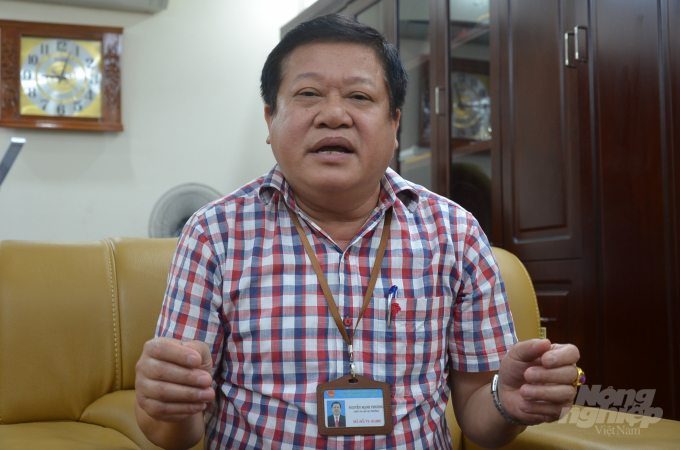
Nguyen Manh Phuong, Director of the Hanoi Plant Protection and Cultivation Sub-Department. Photo: Duong Dinh Tuong.
Putting into comparison with other provinces, how the situation Hanoi pesticide usage?
If comparing to other northern provinces, the area of planting in Hanoi just follows Thanh Hoa province, with 150,000 ha, with 100,000 ha of rice plant. Over the past 4-5 years, Hanoi used over 320 tons of pesticides for plants per year but the number reduced to 239 tons in 2020, equivalent to 1.5 kg per ha per year, of which some districts witnessed the reduction in pesticides usage including Phu Xuyen (0.26 kg per ha per year), Chuong My (0.3 kg per ha per year), and Ung Hoa (0.3 kg per ha per year) among others.
Hanoian farmers used fewer pesticides thanks to regular training in rice, veggies, fruits, and tea planting, and they were handed over cutting-edged scientific and technical progression as well as knowledge in production.
How are the roles of technical and plant protection workers as the system of "centipedes" at the commune level, sir?
The system was launched before Ha Tay district integrated into Hanoi, however, it was considered a supplementary unit. For 10 years now, we have had a system of 4,000 staff at each commune who take on 9 missions including giving advice to the People’s Committee at multiple levels in performing state management functions on crop production and plant protection; estimate and forecast pest management for plants; planning on agricultural land use; food safety and hygiene among others.
“It is not true to say that we do not use any pesticides at all, to some thresholds, pesticide usage is a must. Even in the world, people are also forced to use pesticides when pests and diseases develop in the threshold of harm, but use to what extend and how to use is worth mentioning."- Head of the Cultivation and Plant Protection Division in Hanoi, Nguyen Manh Phuong.
Unlike many provinces and cities that have abandoned integrated pest management (IPM) classes, Hanoi has maintained it since 1992 on rice, vegetables, fruit trees, among others with the number of classes reaching 50-70 on average since 2009 after the scheme on clean vegetables had been approved.

Inspection of pests and diseases on vegetables in Thuy Huong, Chuong My district, Hanoi. Photo: Duong Dinh Tuong.
All commune-level crop protection staff were trained through practical field pest management classes. These crop and plant protection workers are paid by the sub-department.
"We expect Hanoi city to hold the civil service exam for this contingent of crop protection and crop protection staff, paying salary according to their job position to secure them with their job, so that we can easily manage them. With low wages, the staff will get bored leading to time-consuming for training. This way of system establishment of crop protection staff at commune level was available in some provinces but now I don't know if it can still be maintained or not and I wonder if the salary is paid according to qualifications like Hanoi?" said Nguyen Manh Phuong.
How do you assess the difference between farmers today and whom ten years ago?
In the past, farmers used to worked in the form of generation to generation without the support of knowledge, so that they can not even acknowledge what is safe production, what is VietGap, what is organic. However, farmers today are well trained on how to pick the variety, how to use land, how to fertilize and care for the plant to prevent pests. When it comes to the threshold that demands pesticides, they use the right types of pesticides, the right subjects, mix the right concentrations, pump the pesticides properly, not indiscriminately like in the past.
Not every pesticide or drug is toxic but also depends on whether it is chemical or biological. So what is the rate of biological drugs in Hanoi, sir?
The transformation from chemical crop protection agents to biological one has been implemented for 8-10 years and the rate of biological pesticides in Hanoi is 60%. To change farmers’ awareness, besides long-term IPM classes, the city also holds short-term training classes for them.
We often discuss with farmers that biological drugs are different from chemicals in that the pests won't die immediately but they will fell ill, lay still and unable to destroy the plant. The key issue in food safety is that at the end of the season, priority must be given to the use of biological drugs and herbs.
Recently, administrative violations on food safety and hygiene in Hanoi are strictly handled at three levels from the city, the district to the commune. Except for goods at the wholesale market, which are imported from many sources, including provinces and cities, it is difficult to control, but most of Hanoi's agricultural products are up to standards.
The hardest task is reducing pesticides usage on veggies, so can you elaborate on how did Hanoi do in detail?
When the scheme on safe production and consumption of vegetables in Hanoi during 2009-2016 was taken into effect, the area certified for food safety reached over 5,000 hectares, the largest in the country. The output of safe vegetables is nearly 400,000 tons per year, meeting 40% of consumer demand. Every year, we analyze 300-1,000 samples of vegetables, only 1-2% exceed the maximum limit of pesticide residues.
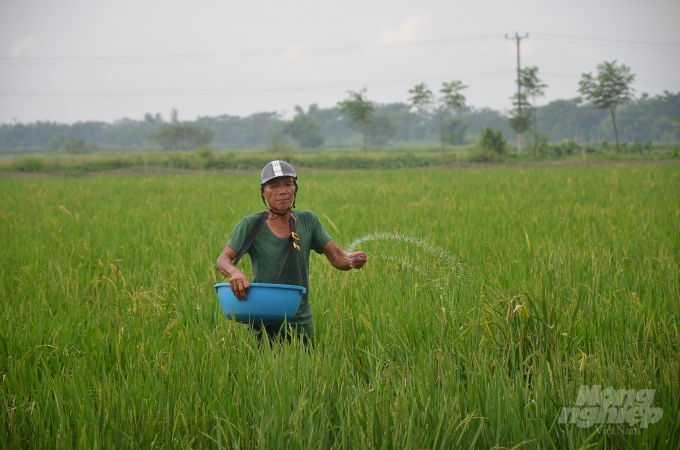
Fertilizing for paddy rice in the rice-fish-duck model in Nam Trieu commune, Phu Xuyen district, Hanoi. Photo: Duong Dinh Tuong.
To achieve the above results, we have organized 1,139 training classes on IPM vegetable for 34,170 farmers, 100% of farmers accepted and applied it, and promoted it to 50,000 other farmers; 897 short-term training courses on food safety in safe vegetable production for 49,500 people, 100% of the producers understood the regulations on food safety. Deploying and implementing more than 500 trials of new techniques without using pesticides such as plastic mulching, off-season vegetable net houses among others.
In the beginning, the Sub-department provided support for biological pesticides and herbs for farmers, but Resolution 10 was implemented, the supporting materials were assigned to the district. Since then, the support of biological drugs and herbs is not synchronized.
A few years ago, there were shortcomings in certifying 5,000ha of safe vegetables in Hanoi, how is it now?
Previously, the city assigned the Department of Plant Protection to take soil and water samples and issue certificates of eligibility. The certificate is only valid for three years.
Most vegetable production today is represented by cooperatives, but only true business units are eager to submit for the re-grant of the certification. Currently, the reissue rate is only about 50%.
According to Circular 51 (now Circular 17) of the MARD, all manufactured goods must be safe when brought out to the market, so not only more than 5,000 hectares have been granted a certificate of eligibility but also over 12,000ha of vegetables of the whole city must be ensured to follow safety production requirements. Small-scale production households must sign a commitment with the communes and wards to produce vegetables safely.
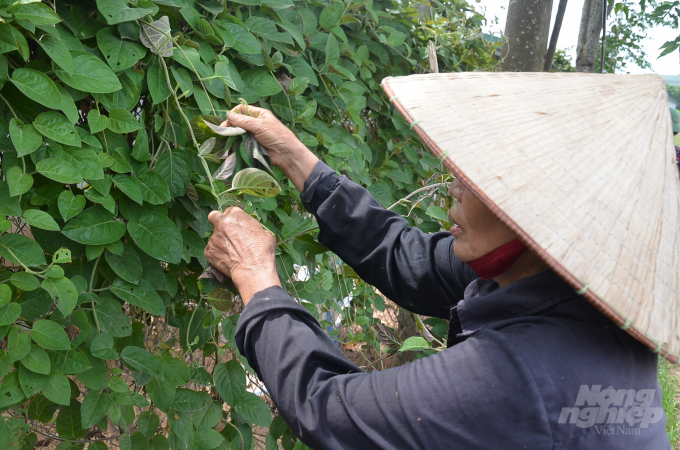
Harvesting apricots in Quang Be commune, Chuong My district, Hanoi. Photo: Duong Dinh Tuong.
Hanoi has done a good job in controlling pesticides on agricultural products. However, at present, the use of pesticides on flowers and ornamental plants is still high in some specialized areas of Hanoi (Me Linh, Bac Tu Liem...). So can you tell us about the upcoming direction for flowers and ornamental plants?
We will open many IPM classes on flowers to improve knowledge and communicate with people. Secondly, implementing several models to reduce pesticides on flowers and ornamental plants. From that, the commune and village will issue local management regulations on the use of pesticides to reduce them.
Based on the reality of reducing pesticides, in your opinion, can provinces and cities do the same as Hanoi?
It is still possible to do it, but there must be funds to build a team of “centipedes” staff at the commune level, which are plant and plant protection workers. Short-term, long-term training courses and demonstration models must be organized. Instructions to direct pests and diseases to each region, each field, and each parcel to avoid the situation of overuse of pesticides.
Thank you, Sir!
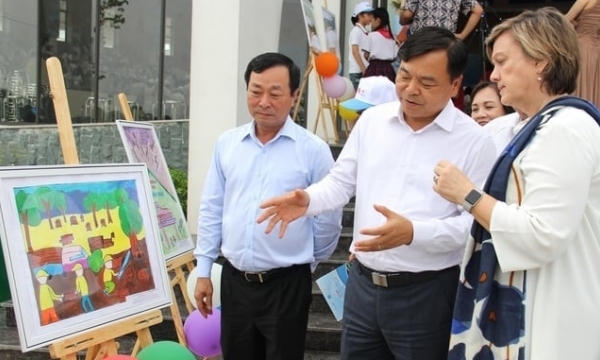
(VAN) According to Deputy Minister Nguyen Hoang Hiep, anticipatory action is a new approach in disaster management, with the aim of enhancing disaster prevention and preparedness.
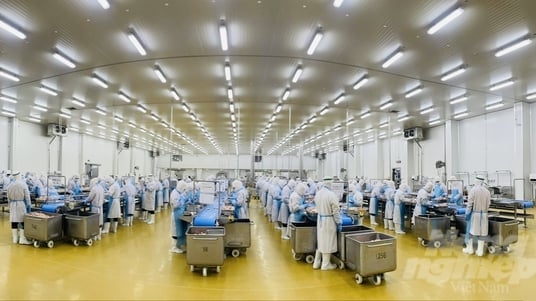
(VAN) The Ministry of Agriculture and Rural Development, in coordination with Tay Ninh Provincial People's Committee, organized a conference on May 18 to promote the export of animals and animal products.
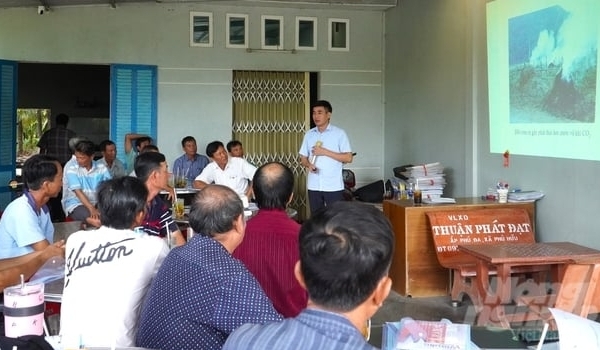
(VAN) From May 17-23, the National Agricultural Extension Center (NAEC) conducts training classes on the advanced rice farming process at 5 localities piloting for the 1 million ha of high-quality rice scheme.
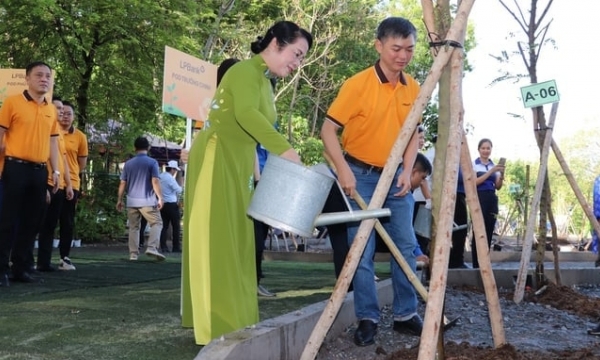
(VAN) Planting and expanding green spaces is a crucial effort to mitigate and adapt to the impacts of climate change, thereby creating a clean and livable environment.
/2024/05/17/5720-1-134847_782.jpg)
(VAN) EcoTraceTech - System for measuring CO2 and CH4 emissions from rice plants is the startup idea of a group of Can Tho University students.
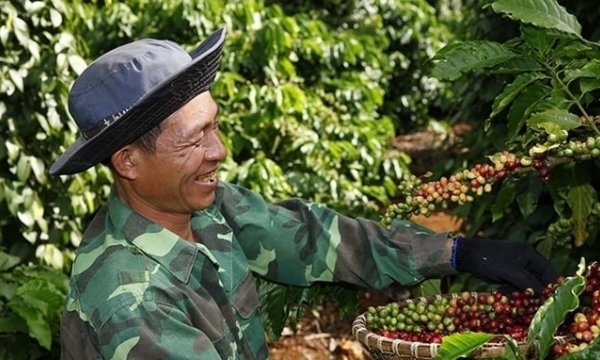
(VAN) The NESCAFÉ Plan by Nestlé Vietnam in the Central Highlands together with MARD aims to support coffee farmers in regenerative agriculture.
/2024/05/16/4437-1-223910_491.jpg)
(VAN) The Community Food Garden model is one of the outstanding activities and models of green transformation in the world as well as in Vietnam.